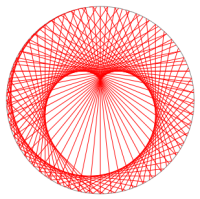The Mellin transform
Definition
Let \(\mathbb{R}^{+}\) be the set of positive real numbers. Given a function \(f\) on \(\mathbb{R}^{+}\), define the Mellin transform of \(f\), whenever it makes sense, as follow: \[\mathcal{M}(f)(s)=\int_{0}^{\infty} f(t)t^{s} \frac{dt}{t}. \; (1)\]
The very first example of the Mellin transform I have known is the gamma function, \[\Gamma(s) = \int_{0}^{\infty} e^{-t}t^{s} \frac{dt}{t},\] which is the Mellin transform of the function \(e^{-t}\).
Relation with Fourier transform
The Mellin transform is indeed the Fourier transform on the locally compact group \((\mathbb{R}^{+}, \cdot)\). There is a general way to look into the Fourier transform of \((\mathbb{R}^{+}, \cdot)\), but there is an easier way to discover the connection between these two transforms. I will go through both ways here, with the easier one first.
Let \(exp: (\mathbb{R}, +) \to (\mathbb{R}^{+}, \cdot)\) be the obvious exponential map. It’s not hard to see that \(exp\) is an isomorphism. For a function \(f\) on \(\mathbb{R}^{+}\), we can composite it with \(exp\) to define a function \(\tilde{f}=f \circ exp\) on \(\mathbb{R}\). Applying the Fourier transform to \(\tilde{f}\), we get \[\begin{split} \mathcal{F}(\tilde{f})(y) &=\int_{-\infty}^{\infty} \tilde{f}(x)e^{2\pi ixy} dx \\ &=\int_{-\infty}^{\infty} f(e^x)e^{2\pi ixy} dx \, . \end{split}\] Now, we let \(t=e^x\) and \(s=2\pi iy\), then \[\mathcal{F}(\tilde{f})\left(\frac{s}{2\pi i}\right)=\int_{0}^{\infty} f(t)t^{s} \frac{dt}{t}.\] So we conclude from above that \(\mathcal{M}(f)(s)=\mathcal{F}(f \circ exp)\left(\frac{s}{2\pi i}\right)\).
We should now consider the Fourier transform directly on \((\mathbb{R}^{+}, \cdot)\). The usual Fourier transform is considered on \((\mathbb{R}, +)\) and can be generalized to locally compact abelian groups. For more information about the Fourier transform on locally compact abelian groups, see this wikipedia article: Pontryagin duality. The Fourier transform can be further generalized, to the Gelfand transform.
In order to do the Fourier transform on \((\mathbb{R}^{+}, \cdot)\), we need to figure out the dual group and the Haar measure of \(\mathbb{R}^{+}\).
The proof of claim 1 is not hard. One way to see it is derivation via the isomorphism \(exp\) from \(\hat{\mathbb{R}}\), the dual group of \(\mathbb{R}\). For \(\theta \in \mathbb{R}\), we denote \(\chi_{\theta}\) a character of \(\mathbb{R}^{+}\), defined by \(\chi_{\theta}(t) = t^{i\theta}\), as in claim 1. Since \(\widehat{\mathbb{R}^{+}} \cong \mathbb{R}\), we can identify \(\theta\) with \(\chi_{\theta}\), so it makes sense if I say \(\theta \in \widehat{\mathbb{R}^{+}}\). Again, by using \(exp\), we can get the Haar measure on \(\mathbb{R}^{+}\) easily:
With claim 1 and claim 2 in hand, we can now proceed to the Fourier transform on \(\mathbb{R}^{+}\). Fix a function \(f\), for any \(\theta \in \widehat{\mathbb{R}^{+}}\), \[\begin{split} \mathcal{F}_{\mathbb{R}^{+}}(f)(\theta) &= \int_{\mathbb{R}^{+}} f(x)\chi_{\theta}(x) \frac{dx}{x}\\ &= \int_{\mathbb{R}^{+}} f(x)x^{i\theta} \frac{dx}{x} \, .\end{split}\] From this, we see that \(\mathcal{M}(f)(s)=\mathcal{F}_{\mathbb{R}^{+}}(f)(-is)\).
In both cases where we relate the Mellin transform to the Fouire transform, we do the substitution \(s=2\pi iy\) or \(s=i\theta\), where \(y, \theta \in \mathbb{R}\). So \(s\) should be a pure imaginary on the upper plane. In the application section below, we do focus on the function defined on the positive imaginary axis. However, we should notice that the definition (1) of the Mellin transform does not require \(s\) to be pure imaginary.
Inversion
Since we know from the previous section that the Mellin transform is indeed a special kind of the Fourier transform, we can use the Fourier inversion formula to obtain the inversion formula for the Mellin transform: \[\mathcal{M}^{-1}(\varphi)(t) = \frac{1}{2\pi i} \int_{v-i\infty}^{v+i\infty} \varphi(s)t^{-s} ds, \; (2)\] where \(v\) is a real number.
The proof of the inversion formula (2):
Let \(f\) be a function on \(\mathbb{R}^{+}\). Let \(\varphi(s) = \mathcal{M}(f)(s)\) as defined in (1). Let \(s=v+iw\), where \(v, w \in \mathbb{R}\), and let \(t=e^{x}\), where \(x \in \mathbb{R}\). Then \[\varphi(v+iw)=\int_{-\infty}^{\infty} f(e^{x})e^{xv}e^{ixw} dx.\] So by the Fourier inversion formula, \[f(e^x)e^{xv} = \frac{1}{2\pi i}\int_{-\infty}^{\infty} \varphi(v+iw)e^{-ixw} dw.\] Now, multiplying both sides by \(e^{-xv}\) and plugging \(t=e^x\) and \(s=v+iw\) back, we get (2).
Application
I found out that the Mellin transform is extensively used in proving functional equations and analytic continuations of automorphic forms, in Daniel Bump’s Automorphic Forms and Representations. I will show the idea by proving the analytic continuations and functional equations of modular forms for \(SL(2, \mathbb{Z})\).
Let \(\mathcal{H}\) be the upper complex plane. Let \(f\) be a holomorphic function on \(\mathcal{H}\) satisfying:
- \(f(z+1)=f(z)\);
- \(f(-1/z)=z^{k}f(z)\), where \(k \in 2\mathbb{N}\);
- \(f\) has a Fourier series \[f(z)=\sum_{n=0}^{\infty} a_ne^{2\pi inz}. \; (3)\]
Such a function \(f\) is called a modular form of weight \(k\) for \(SL(2, \mathbb{Z})\).
Since \(f\) is holomorphic on \(\mathcal{H}\), \(f\) is uniquely determined by the values it takes on the upper imaginary axis, by the identity theorem. Hence, it suffices to consider how \(f\) behaves on \(i\mathbb{R}^{+}\). Now let’s apply the Mellin transform to \(f(iy)\), where \(y \in \mathbb{R}^{+}\): \[\mathcal{M}(f)(s) = \int_{0}^{\infty} f(iy)y^s \frac{dy}{y}.\] By using the Fourier series (3) of \(f\) and exchanging the order of summation and integration, and then letting \(t=2\pi ny\) in each integration, we get: \[\begin{split} \mathcal{M}(f)(s) &= \sum_{n=0}^{\infty} \int_{0}^{\infty} a_ne^{-2\pi ny}y^s \frac{dy}{y} \\ &= (2\pi)^{-s}\Gamma(s) \sum_{n=0}^{\infty} \frac{a_n}{n^s} \\ &= (2\pi)^{-s}\Gamma(s)L(s, f) \, , \end{split} \; (4)\] where \(L(s,f)=\sum_{n=0}^{\infty} \frac{a_n}{n^s}\) is the \(L\)-function of \(f\). Apparently, (4) indicates the analytic(meromorphic) continuation of \(L(s,f)\).
Now putting \(z=iy\) into \(f(-1/z)=z^{k}f(z)\), we get \(f(iy)=i^{k}y^{-k}f(i/y)\). So, \[\begin{split} \mathcal{M}(f)(s) &= \int_{0}^{\infty} f(iy)y^s \frac{dy}{y} \\ &= \int_{0}^{\infty} i^{k}f(i/y)y^{s-k} \frac{dy}{y} \\ &= i^k \int_{0}^{\infty} f(iy)y^{k-s} \frac{dy}{y} \\ &= i^k \mathcal{M}(f)(k-s) \, . \end{split} \; (5)\]
Define \(\Lambda(s,f)=(2\pi)^{-s}\Gamma(s)L(s,f)\). Then by (4) and (5), we obtain the functional equation of \(f\): \[\Lambda(s,f)=i^{k}\Lambda(k-s,f).\]
